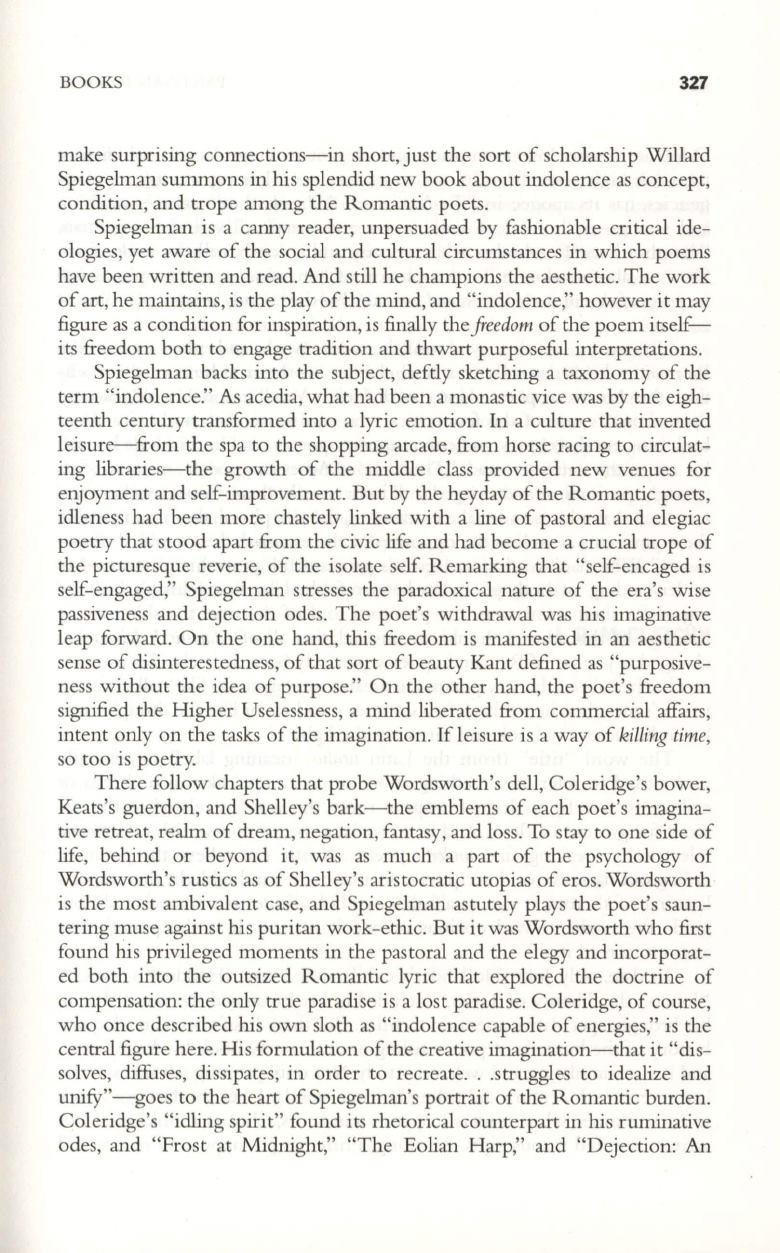
BOOKS
327
make surprising connections-in short, just the sort of scholarship Willard
Spiegelman summons in his splendid new book about indolence as concept,
condition, and trope among the Romantic poets.
Spiegelman is a canny reader, unpersuaded by fashionable critical ide–
ologies, yet aware of the social and cultural circumstances in which poems
have been written and read. And still he champions the aesthetic. The work
of art, he maintains, is the play of the mind, and "indolence," however it may
figure as a condition for inspiration, is finally the
freedom
of the poem itself–
its freedom both to engage tradition and thwart purposeful interpretations.
Spiegelman backs into the subject, deftly sketching a taxonomy of the
term "indolence." As acedia, what had been a monastic vice was by the eigh–
teenth century transformed into a lyric emotion. In a culture that invented
leisure--from the spa to the shopping arcade, from horse racing to circulat–
ing libraries-the growth of the middle class provided new venues for
enjoyment and self-improvement. But by the heyday of the Romantic poets,
idleness had been more chastely linked with a line of pastoral and elegiac
poetry that stood apart from the civic life and had become a crucial trope of
the picturesque reverie, of the isolate self. Remarking that "self-encaged is
self-engaged," Spiegelman stresses the paradoxical nature of the era's wise
passiveness and dejection odes. The poet's withdrawal was his imaginative
leap forward. On the one hand, this freedom is manifested in an aesthetic
sense of disinterestedness, of that sort of beauty Kant defined as "purposive–
ness without the idea of purpose." On the other hand, the poet's freedom
signified the Higher Uselessness, a mind liberated from commercial affairs,
intent only on the tasks of the imagination. If leisure is a way of
killing time,
so too is poetry.
There follow chapters that probe Wordsworth's dell, Coleridge's bower,
Keats's guerdon, and Shelley's bark-the emblems of each poet's imagina–
tive retreat, realm of dream, negation, fantasy, and loss. To stay to one side of
life, behind or beyond it, was as much a part of the psychology of
Wordsworth's rustics as of Shelley's aristocratic utopias of eros. Wordsworth
is the most ambivalent case, and Spiegelman astutely plays the poet's saun–
tering muse against his puritan work-ethic. But it was Wordsworth who first
found his privileged moments in the pastoral and the elegy and incorporat–
ed both into the outsized Romantic lyric that explored the doctrine of
compensation: the only true paradise is a lost paradise. Coleridge, of course,
who once described his own sloth as "indolence capable of energies," is the
central figure here. His formulation of the creative imagination-that it "dis–
solves, diffuses, dissipates, in order to recreate. ..struggles to idealize and
unifY"-goes to the heart of Spiegelman's portrait of the Romantic burden.
Coleridge's "idling spirit" found its rhetorical counterpart in his ruminative
odes, and "Frost at Midnight," "The Eolian Harp," and "Dejection: An


